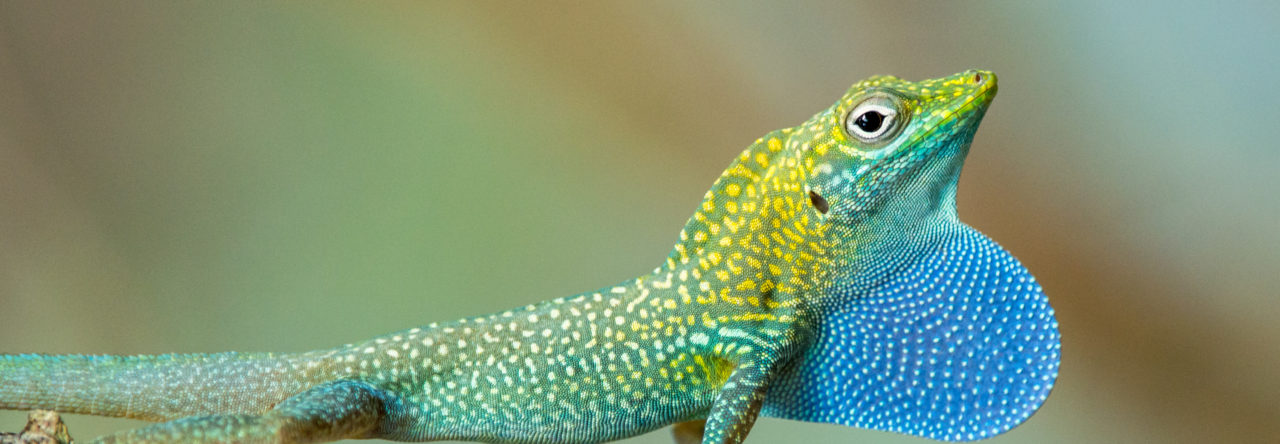“It must be the oldest part of Mérida…. In the afternoon when the sun lights the stucco buildings across the street, it’s possible to count a dozen different colors of paint, all fading together on the highest part of the wall…. Cats stalk lizards among the clay pots around the fountain, doves settle into the flowering vines and coo their prayers, thankful for the existence of lizards.” – The Lacuna, a novel by B. Kingsolver (2009; Harper Perennial; pp.393)
Mérida is the capital city of the Mexican state of Yúcatan. Of the lizards alluded to in the passage above, some were undoubtedly anoles. Anoles are well known for their radiation in the Caribbean but are less appreciated for their radiations in mainland Central and South America, which rival their Caribbean counterpart in species diversity and morphological disparity.
(I say radiations because there were actually two radiations on the mainland. The first mainland radiation includes the basal clade of Anolis and is paraphyletic because the Caribbean radiation arose from within it. The second radiation, monophyletic, is actually a back-colonization of the mainland from the Caribbean.)
Which mainland anoles could be in Mérida? There are five anoles whose species distribution places them near or in Mérida: Anolis sagrei, A. lemurinus, A. tropidonotus, A. rogdriguezii, and A. sericeus. We’ll explore the natural history of these species to determine for which one(s) Mérida’s doves are thankful.
(1) Anolis sagrei, the brown anole, is not actually a mainland anole. This Cuban species is well known for its invasive abilities. For example, it has invaded the southeast U.S., Jamaica, Central America, Hawaii, and even Taiwan. Cats are known to feast on Anolis sagrei in other parts of its range, and there is a record of A. sagrei in Mérida; however, because The Lacuna is set in the early 1950s, we will assume that A. sagrei had not yet arrived in Mérida to fall prey to cats.
(2) Anolis lemurinus is a grey-colored anole, found in the understory of lowland forests. Individuals of this species are partial to shaded habitats and perch on the buttresses of trees while they watch and wait for their invertebrate prey. Often, they are heard scampering along the forest floor before they are seen. Perhaps this is why this species is called lemurinus, which means “belonging to the ghosts of the dead” in Latin. Anolis lemurinus is probably not food for Mérida’s cats for two reasons: (1) Mérida lies just beyond the edge of the species range for A. lemurinus, and (2) A. lemurinus is a forest, not city, dweller.

Anolis lemurinus - photo by Michael Benard http://calphotos.berkeley.edu/cgi/img_query?enlarge=0000+0000+0107+1742
(3) Anolis tropidonotus lives in primary and secondary forests. It too is a forest dwelling anole, preferring shady habitats. Individuals in this species are predominantly terrestrial and will burrow into the leaf litter to escape capture. Like A. lemurinus, A. tropidonotus is primarily a forest species and its range nears but does not include Mérida. Thus, it is an unlikely candidate.

Anolis tropidonotus - photo by Josiah Townsend http://www.flickr.com/photos/24831531@N07/2353154759/
(4) Anolis rodriguezii is a small anole that can be found most often in dry forests but in other forest types too. It usually perches several meters high but is known to descend out of the canopy to the ground. It also scrambles along the walls of ancient Mayan ruins. There is record of this species from Mérida, so it is probably common in the forests around Mérida, may venture into human establishments, and could be falling prey to cats in Mérida
<Please send me a photo if you have one>
(5) Anolis sericeus is a small anole too. This species prefers open savanna habitats, forest edges, and areas disturbed by human activity. Individuals in this species perch on shrubs, bushes, and grass tufts. Males of this lizard have a striking dewlap that is yellow with a blue or purple spot in the center. Given this species’s penchant for human-impacted environments and its near-ground perching habits, A. sericeus seems the mostly likely anole candidate to be cat food in Mérida.
A haiku from the doves in homage to A. sericeus:
Coo-rageous anole,
Anolis sericeus.
Distracts pesky cats.
Many thanks to Julian C. Lee. I collected most of the information about the anoles of Mérida from his two books: The amphibians and reptiles of the Yucatan Peninsula (1996 – Comstock Publishing) and A field guide to the amphibians and reptiles of the Maya world (2000 – Cornell University Press).







